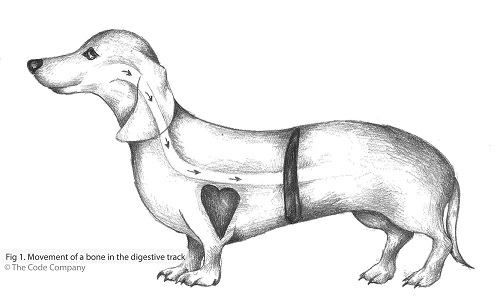 Although most of us grew up with the assumption that bones are good for our pets this is in fact a fallacy, one that more pet owners should be made aware of. Let’s look at some effects and risks involved when feeding bones to pets.
Although most of us grew up with the assumption that bones are good for our pets this is in fact a fallacy, one that more pet owners should be made aware of. Let’s look at some effects and risks involved when feeding bones to pets.
The Good:
The unfortunate truth is that the only good thing about feeding your dog bones is that they like it and it keeps them busy, especially if they have a tendency to chew. Sadly just as we all enjoy our McDonalds, KFC and pizza we know these foods are not good for our health and the same applies to bones for your dog. They carry no nutritional value and are indigestible. Perhaps the only part of the bone a dog may actually eat and digest would be bone marrow.
The Bad and the Ugly
To ensure we cover all the possible untoward effects of bones we will start with a tip to tail approach. Firstly chewing bones can fracture your dog’s teeth, this may range from a mild chip fracture to complete crown-root fracture, which may require dental extraction. Bone splinters may damage the soft tissues of the mouth predisposing to infection. A fairly common occurrence in every veterinary practice is the case of a dog with a bone stuck in his/her throat or between his/her teeth. As one may imagine having a bone stuck anywhere in your mouth is painful, irritating and can cause a lot of damage. Dogs, not having the advantage of fingers, are unable to remove these bones themselves and as such veterinarians are left with the job of trying to pry these troublesome bones out of mouths that are not exactly very compliant. Often patients need to be sedated or put under general anaesthetic to be able to remove the bone.

Moving further on in our dog’s digestive tract, we find ourselves in the oesophagus, the soft muscular tube connecting the mouth to the stomach. The oesophagus run through the chest between the lungs and over the heart. There are 4 main areas in the oesophagus where bones can find themselves stuck. These include the entrance to the oesophagus as mentioned about, the entrance into the chest cavity, over the base of the heart and lastly at the exit of the oesophagus from the chest cavity through the diaphragm and into the stomach.
Should a bone become stuck anywhere along the oesophagus it could pierce the wall or, with pressure and time, the wall may die off. If either of these happen severe infection within the chest cavity will result. Even if it is just stuck it will require specialist surgery or endoscopy to remove it or push it into the stomach.
Once in the stomach these bones can damage the wall or become stuck and unable to move through. The same applies all the way down the digestive tract. A bone can make it all the way to the rectum and become lodged at the exit of the anus. The variety of clinical signs you as an owner can expect is anything from vomiting, diarrhea (both of which may be bloody), constipation, lack of appetite, abdominal pain and many more. The treatment can vary anywhere from over the counter medication to enemas, drip, surgery and prolonged stays in hospital. All of which can become very costly.
It is a common misconception that you may feed some bones and not others.
- chicken bones splinter and are very traumatic,
- chop bones are sharp and hard (the perfect bone to pierce through soft tissues),
- large marrowbones can be fed as long as the bone is taken away from the dog once the marrow has been eaten otherwise they are an obstruction waiting to happen,
- any large bone not big enough to swallow can still be chewed, risking broken teeth and pieces may still be chewed and swallowed which can still be problematic with constipation and bloody diarrhoea always a risk.
So the question is, “are there alternative chew treats besides that favorite pair of shoes that have already been chewed?” Raw hide chews, dried pig’s ears and ostrich tracheas are all safe and cost effective chew treats for your pets. Pig’s hooves can also be fed but it is recommended this be done under supervision as on rare occasions over eager dogs may try swallowing it without chewing. There are also other treats and chews on the market that make healthy and safe alternatives to bones. These also help to keep your pets teeth clean of plaque build-up.
Many pet owners may argue that they have fed their dogs bones for many years and nothing has ever happened. This may very well be true but it only takes one mishap for disaster to strike, and often when it does it may be life threatening to your dog as well as being very costly for you to get them up and going again. So why take the risk of all these potentially life threatening consequences for something that is not even good for your beloved dog?
© 2018 Vetwebsites – The Code Company Trading (Pty.) Ltd.


